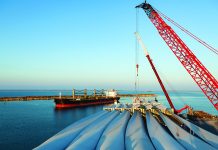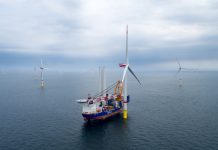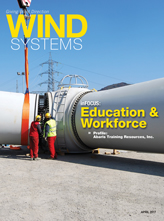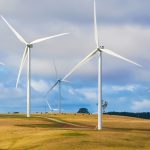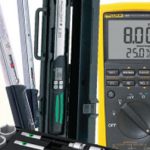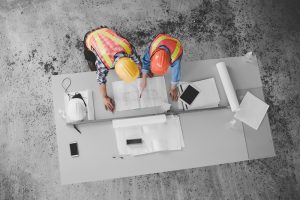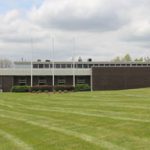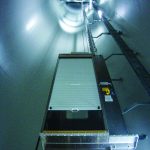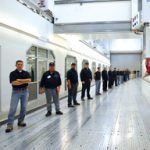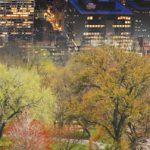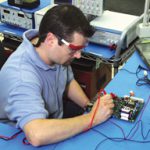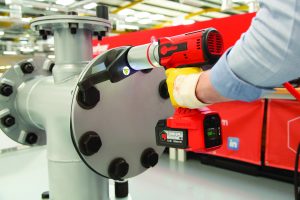Abaris Training Resources, Inc. trains wind-turbine blade maintenance personnel in proper composite repair practices.
But that expertise in wind actually started in the aerospace industry.
“When you think about a wind blade, it’s just an airfoil, so we look at it as a wing,” said Louis Dorworth, direct services manager with Abaris Training.
Abaris has partnered with some major wind-farm maintenance providers to teach them and keep their teams up-to-date on repair methods and new technology.
“This is especially important as blades get larger and incorporate more efficient materials and more optimized designs,” Dorworth said.

26 Available Classes
Abaris started in 1983 with one repair class, and now it’s expanded to more than 26 classes that surround a variety of subjects.
“Composite repair is our bread and butter,” Dorworth said. “Oftentimes, we get involved with companies that are challenged with some repair situation. And in that case, they may hire us to actually help with that problem. That’s where we get our knowledge: from working with our customers across all industries.”
Some of the questions companies want answered include: How do they approach a repair? How do they get the best process? And how do they get the best repair instruction written?
“We get involved a lot at that level,” Dorworth said. “Our group as a whole are pretty much experts in the repair area. And we transfer that technology to wind, automotive, transportation, and various other industries that are trying to do repairs. So we have a lot of experience in that area.”
Aerospace Expertise

Abaris leads the way in improving the structural integrity of field repairs by transferring its experience from the aerospace industry to wind, according to Dorworth.
“The baseline fiberglass wind-blade repair techniques of yesterday that were largely based upon antiquated ‘marine’ type repair methods, have been replaced in our training with modern structural repair methods and techniques that produce a more efficient aeroelastic and/or aerodynamic structural repair that would be deemed ‘airworthy’ in the aerospace sector,” he said. “This is important as blade sizes increase and new enhanced blade designs are becoming more mainstream.”
When companies come to Abaris needing solutions, Abaris has several options it can present.
“We have so many courses that we have on the shelf,” Dorworth said. “We are able to sometimes pull modules from different classes and make a custom course without having to charge them extra for that customization. Other times, they want us to deal with their own specifications and their own knowledge base. In that case, we customize a course based on their requirements, and we contract to do that.”
When Abaris creates a custom class for a client, that’s their class, he said.
“They can use that class as they will,” Dorworth said. “But they normally contract us to come back and teach it.”
“Train The Trainer”

Part of that can involve activities where Abaris instructors teach customers how to train their people once they have completed an Abaris course.
“We do have a ‘train the trainer’ class that we provide,” Dorworth said. “It covers the basic fundamentals. We don’t care what subject they want to teach, as long as it’s composite related. We will bring them to a level in which we feel that they can communicate with students at a level that will be suitable — and we certify that.”
In a word, Abaris is flexible, according to Dorworth.
“We could be described as a very flexible organization in what we can do for our clients,” he said.
One of Abaris’ main goals is to make sure repair teams are well educated.
“We’re part of that effort,” Dorworth said. “We work with a lot of different blade maintenance providers, and they come in with skills in repairing the erosion issues very well.”
But Abaris enters the picture when it comes to structural repairs.
From Beginner To Advanced

“We have had organizations that have contracted us for beginner — if you will — blade repair, and then, a year later, for more advanced blade-repair training, maybe even getting into internal structures such as carbon spar caps and that sort of thing,” Dorworth said.
Structural elements of a wind turbine — such as carbon fiber — are perfectly normal areas Abaris deals with thanks to its aerospace knowledge.
“But they’re not so normal to the typical wind-farm maintenance crew, so that’s something that we can provide and transfer our aerospace knowledge over to wind,” Dorworth said. “We take our background, our experience, our knowledge, and we try to approach, not only the maintenance providers, but sometimes the owners and OEMs, too.”
Abaris promotes repair procedures that reduce the risk of damage to the existing structure when removing materials around the damaged area. Abaris teaches the use of a taper-scarf approach as opposed to a step-scarf approach.
The taper-scarf approach prevents a technician from causing more damage to a blade that is being repaired.
The taper-scarf technique also allows the replacement of the fiber reinforcements in a manner that more efficiently transfers the dynamic loads through the composite turbine blade skins, according to Dorworth. This is accomplished by breaking the bulk constituent materials down into subgroups of fibers and doing the repairs to those subgroups.
An example of this is where a multi-axial glass fabric form has been used to manufacture a blade skin, and the repair requires replacement of fiber-loads on different axes of orientation. The common approach was to replace the entire multi-axial form with the same bulk form in the repair. This method limits the load transfer through the structure.
Instead, Abaris teaches the repair technician to recognize that each subgroup “uni-directional” layer located within the bulk multi-axial form must be replaced on-axis, to achieve proper load distribution through each independently oriented fiber layer.
“It sounds complicated, but it is quite simple and in some ways, easier to accomplish,” Dorworth said.
From How To Why

An extra step Abaris takes with its training courses is moving beyond just the “how to repair” to the “why it is done a certain way.”
“One thing we’ve learned from our students is that if they know why it’s important to perform things in a certain manner, they’re more apt to perform the techniques that allow for a better repair,” Dorworth said. “But they have to know why, and they need to know what they’re looking for.”
It’s a natural progression, according to Dorworth, and it’s one that holds a sense of accomplishment when that lightbulb goes on.
“At first, they’re kind of green,” he said. “They’re learning all these things, but once they get to a level of understanding of what you’re trying to do, they’re cognizant of the mission. Not just fill in the hole — not just put a patch on there so water doesn’t get in — we want to regain the load path in the fiber-reinforced composite blades. And that’s the bottom line.”
That is something that Dorworth said Abaris learned a long time ago in the aerospace industry.
And those training roots go quite deep.
Lear Fan History

Abaris was founded by William Murphy in 1983. Murphy was a former vice president of operations at Lear Fan LTD. The Lear Fan was the first all-carbon fiber aircraft.
Abaris brought several former Lear Fan alumni on board to build a business that would serve the merging advanced composites industry.
In 1989, Michael J. Hoke partnered with Murphy to grow the training side of the business. When Murphy died in 1989, Hoke became the sole owner of the Abaris assets, and Abaris Training Resources, Inc. was formed in 1991 as a separate company committed to advanced composite training.
That pioneering development work has pushed Abaris’ legacy deep into the composite world.
“We developed a company that was committed to work at that forefront of this technology,” Dorworth said. “And, to date, we still try to work on that forefront. That’s our mission: To keep up on the technology and transfer the latest and greatest to our students.”

















